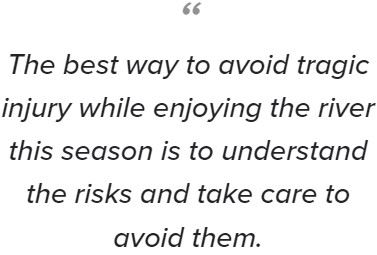Water Safety - Summer Is Coming Part 1
- Category: Healthy Living
- Posted On:

Robert Barnwell, MD
Summer is fast approaching here in Central and South Texas and with it come extreme temperatures. Every year the blazing Texas heat prompts droves of people to flock to nearby waterways, hoping to enjoy a lazy float down the river under the shady Live Oaks. But while floating the river is a great way to beat the Texas heat, there are several notable dangers that all whom partake should be aware of. This will be a four-part series describing some of these dangers, how to prevent them and what to do if they should occur.
Drowning
Drowning is the result of submersion in water and tends to result in death by water gaining passage into the lungs. The amount of water inhaled and the length of time one goes without oxygen are the most important factors when determining the severity of injury from drowning. If the amount of water inhaled is great enough, it can lead to a lack of oxygen and a loss of consciousness that can lead to significant brain damage and eventually death.

Secondary drowning is a rare phenomenon, and the result of a delayed reaction to a near drowning event. If one inhales even a small amount of water, it can result in significant irritation and swelling of the lungs and limit the ability of the lungs to pass oxygen to the bloodstream. Symptoms of secondary drowning may begin within an hour and up to 72 hours after the event and may include shortness of breath, chest pain, extreme exhaustion, ongoing cough and fevers. If someone you know has experienced a near drowning and is exhibiting these symptoms, they should be evaluated by a medical professional immediately.
Per the CDC (Center of Disease Control), drowning ranks 5th among the leading causes of unintentional injury death in the United States. Among the top risk factors for drowning are being of male gender (80% of drowning victims are male), lack of swimming ability, not wearing a life jacket, and alcohol/substance abuse. Since many float the river do so on some type of floatation device (raft, inner tube), those who cannot swim may get the false sense that they are safe and do not require a life jacket. But the truth is that if a person is separated from their flotation device for any reason and does not have the ability to swim back to it, they are at risk for drowning. While we recommend that all who float the river wear a personal life vest, it is especially crucial for non/poor swimmers.
Alcohol is involved in roughly 70% of deaths due to drowning and is known to effect decision making and coordination. When mixed with other drugs (prescription or recreational) these effects are often heightened. To reduce your risk of being a victim of drowning, limiting or avoiding alcohol is highly encouraged.
What Should I Do if I’ve Witnessed Someone Drowning?
Immediately call 911 for help and remove the victim from the water. In doing so, it is important that you are mindful of your surroundings and any potential dangers that might exist, to avoid becoming a victim yourself. As you move the victim, be sure to control and stabilize their head to avoid potential further injury. While waiting for EMS to arrive, start CPR as soon as possible if indicated (victim is not responding, not breathing, or has no pulse). Once EMS arrives, allow them to take over all medical interventions.
Once the patient arrives to the Emergency Department, the Physician and Nurses, will secure the patient’s airway, continue oxygen therapy and begin to treat any associated injuries. Depending on the length of submersion the treatment course may vary. Those with mild symptoms, requiring few interventions will usually be observed for 4-6 hours and if their condition doesn’t worsen, will be discharged home safely. If the patient’s injury is more severe, requiring more intervention, they will be transferred to an Intensive care unit for further management.
The best way to avoid tragic injury while enjoying the river this season is to understand the risks and take care to avoid them. If you cannot swim, consider taking lessons (it is an important life skill) and when you are on the river remember to wear your life jacket, avoid alcohol and drugs and watch out for your buddies. And if you want to go the extra mile, consider taking a CPR course (you never know when it could come in handy).
Please be sure to check back for Part 2: Heat injuries.

Dr. Barnwell is the current medical director at our San Marcos location. Prior to joining Premier, He served as chief of Emergency Medicine Service at the Army’s only Level 1 trauma center, San Antonio Military Medical Center. Dr. Barnwell is board certified in Emergency Medicine and attended medical school at the Uniformed Services University of the Health Sciences.
